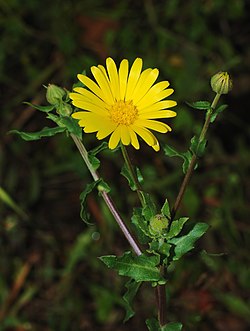| Calendula arvensis | |
|---|---|
 | |
 | |
| Scientific classification | |
| Kingdom: | Plantae |
| Clade: | Tracheophytes |
| Clade: | Angiosperms |
| Clade: | Eudicots |
| Clade: | Asterids |
| Order: | Asterales |
| Family: | Asteraceae |
| Genus: | Calendula |
| Species: | C. arvensis |
| Binomial name | |
| Calendula arvensis | |
| Synonyms [2] | |
List
| |

Calendula arvensis is a species of flowering plant in the daisy family known by the common name field marigold. It is native to central and southern Europe, North Africa and the Middle East [3] and it is known across the globe as an introduced species. [4] [5]
Contents
Calendula arvensis is an annual or biennial herb 10 to 50 cm (3.9 to 19.7 in) tall. The leaves are lance-shaped and borne on petioles from the slender, hairy stem. The inflorescence is a single flower head up to four centimeters wide with bright yellow to yellow-orange ray florets around a center of yellow disc florets. The fruit is an achene which can take any of three shapes, including ring-shaped, that facilitate different methods of dispersal. [6] [7]